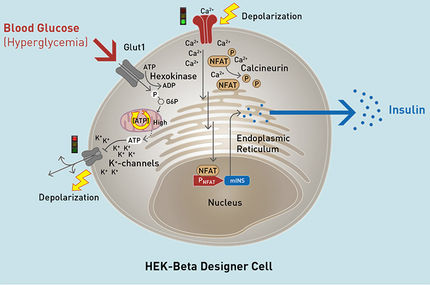How our nerves regulate insulin secretion
Advertisement
The autonomic nervous system, which is the part of the nervous system beyond conscious control, plays an important role in the release of insulin from beta cells in the endocrine part of the pancreas. The process by which this occurs has been a mystery, since it is difficult to give detailed study to such an inaccessible organ.
However, researchers at Karolinska Institutet in Sweden have now managed to graft beta cells into the eyes of mice in order to study them in a living organism over a prolonged period of time. For this study, a technique of transplanting beta cells to the anterior chamber of the mouse eye was used. This technique was previously developed by Professor Per-Olof Berggren’s group at Karolinska Institutet. In the anterior chamber of the eye the beta cells receive a supply not only of blood vessels, but also of nerves from the sympathetic and parasympathetic system, which constitute the autonomic nervous system. Put simply, the sympathetic nervous system can be said to prepare us for flight; one way it does this is to boost our energy by reducing insulin release and increasing glycogen, and consequently blood glucose. The parasympathetic nervous system operates in the reverse direction when we are at rest.
Now, the teams from Karolinska Institutet and the University of Miami have shown for the first time how the autonomic nervous system controls the beta cells and influences the regulation of blood glucose in living animals.
Using fluorescent markers for different types of nerves in combination with advanced microscopy, the researchers were able to probe the animals’ eyes to study in detail the contact between the nerves and the beta cells. When the pupil contracted on exposure to light, the animals’ blood glucose levels plummeted as a direct result of the stimulation of the parasympathetic nervous system. Conversely, when the pupil dilated in darkness and activated the sympathetic nervous system, their blood glucose levels rose. They also managed to influence the animals’ blood glucose levels by inhibiting or stimulating each set of nerves with different substances applied directly into the eye.
“We now understand the fundamentals of how insulin secretion works and is affected by the autonomic nervous system,” says Per-Olof Berggren. “The next step is to see if it works in the same way in people with diabetes or if there are defects in the signalling relevant to the disease pathogenesis.”
Original publication
Rayner Rodriguez-Diaz, Stephan Speier, Ruth Damaris Molano, Alexander Formoso, Itai Gans, Midhat H. Abdulreda, Over Cabrera, Judith Molina, Alberto Fachado, et al.; “Noninvasive in vivo model demonstrating the effects of autonomic innervation on pancreatic islet function”; PNAS 2012.



























































